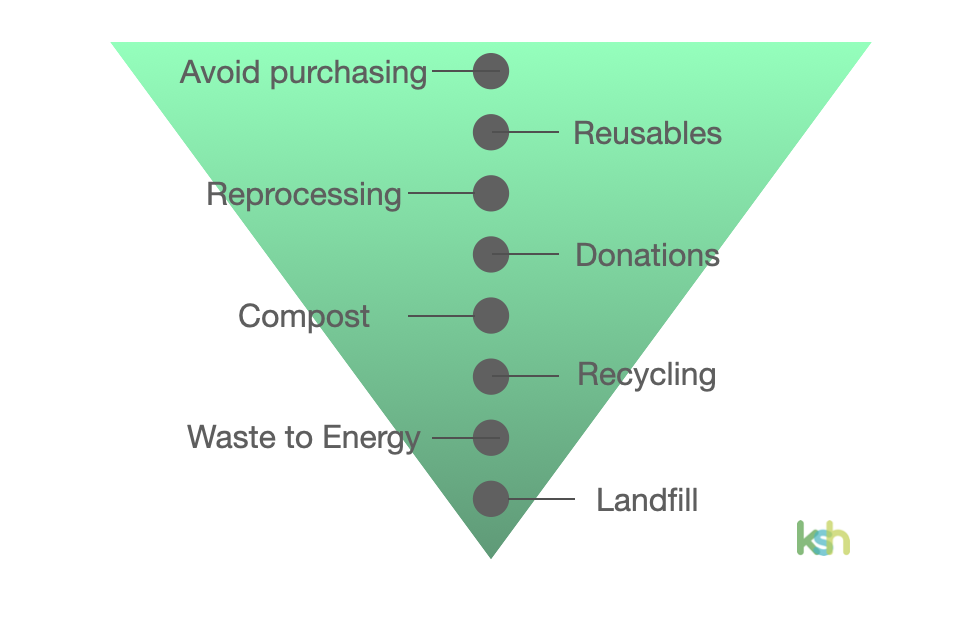Refuse, Reduce, Reuse—Exploring Waste Prevention Strategies for Healthcare Organizations
Effective materials management plans prioritize waste prevention—also known as source reduction—which means reducing waste at the source before it’s ever created. Waste prevention is the most environmentally preferable option. There is no need to manage waste that your organization avoided creating to begin with, so waste prevention efforts save natural resources, reduce costs, and prevent the detrimental impacts of managing materials at their end-of-life.
In materials management, we often refer to the 5 R’s: refuse, reduce, reuse, rot (as in organic waste), and then recycle. Incorporating this into your organization’s sustainability planning creates a framework for prioritizing waste prevention over other management methods as you assess current practices and plan for improvements. Waste prevention can take many forms, including redesigning products to minimize waste, avoiding procuring unnecessary materials, reducing packaging, replacing disposable items with reusable options, donating unneeded supplies, and reducing product toxicity.
Below, we detail examples of waste prevention measures involving refusing, reducing, and reusing in the healthcare industry and discuss what makes these types of measures successful.
Refuse: Reviewing and Reformulating Operating Room (OR) Kits
Operating Rooms produce an estimated 2,000 tons of waste per day, and much of that waste is disposable medical supplies. ORs are also responsible for an estimated 33 percent of all hospital supply costs. A notable source of OR waste is unused medical supplies prepared for each surgical case. To minimize this waste, hospitals can review and reformulate OR kits to increase supply efficiency, conserve resources, and reduce costs.
Practice Greenhealth lists the the following strategies for OR kit review and reformulation:
Review existing OR kits and physician preference cards,
Streamline supply locations so inventory isn’t redundant,
Standardize supply kits,
Focus on the most high volume kits, and
Create an “on hand but unopened” area where items are available but not opened unless they are needed.
As an organization starts an OR kit reformulation process, it is important to track and share cost savings and environmental benefits, and to engage staff to collect feedback.
Reduce: Procuring Plastic-free Supplies
In clinical areas, hospitals are targeting reductions of single-use plastics by substituting with plastic-free alternatives or multi-use products. NewGen Surgical designs clinical supplies such as needle counters and surgical trays using plant-based fibers in place of plastic. Due to the high patient volume in hospitals, these simple changes can have a meaningful impact in reducing plastic waste and natural resource consumption.
Reuse: Moving from Disposables to Reusables
To minimize OR waste, some hospitals are making the switch from single-use surgical gowns and textiles to reusables. Reusable surgical gowns and textiles are typically reused an average 75 times, drastically reducing waste. One study found that replacing disposable surgical linen with reusables achieved a 64.5% reduction in surgical waste. In 2012, UCLA Medical Center began switching to reusable isolation gowns, diverting almost 300 tons of waste from landfills and saving $1.1 million in purchasing costs over a three-year period.
When making the switch from single-use to reusable surgical textiles, quantify current usage of disposables, engage frontline staff and the hospital infection prevention team to select and trial products, and establish a safe and efficient collection process. When implementing any reuse program, ensure that all staff understand the collection procedures.
Another common reuse practice in the healthcare environment is medical device reprocessing. Single-use devices are cleaned and rebuilt, extending the lifecycle of each product and saving on average half the price of new devices. As with any clinical purchasing strategy, employing reprocessing programs requires good stakeholder outreach among leadership, clinicians, and supply chain. The benefits include both supply purchase savings and direct reduction of municipal or regulated medical waste.
Engaging Clinicians in Waste Prevention
Across all of these waste prevention measures, engaging front-line clinical staff is key to a clinical waste reduction program built to last. A major barrier to implementing waste prevention programs in hospitals is the simple fact that any change can be challenging in the complex setting of healthcare. Clinicians are by nature systems thinkers and holistic change agents, and so involving them in waste reduction program planning is critical to program success.
To learn more about engaging clinical staff in waste prevention and other strategies for improving your organization’s materials management program, contact us for a consultation.


